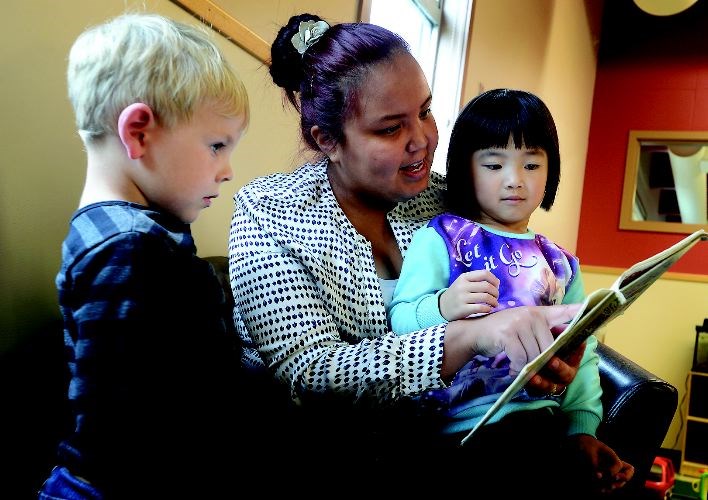There will be a sea of orange T-shirt-clad volunteers in the city this morning offering special edition Prince George Citizen newspapers for donations to the Raise A Reader campaign.
All funds raised will be distributed to local organizations to promote literacy projects in the Prince George community. The event sees about 85 volunteers from many organizations come out to ask for donations including the Prince George Spruce Kings, Integris, Telus and the Prince George Native Friendship Centre.
More than $35,000 was raised during last year's Raise A Reader campaign, which was distributed to 23 local groups that received grants that typically ranged between $1,500 and $2,500.
The Postmedia campaign, organized locally by the Prince George Public Library, Literacy Prince George and the Prince George Citizen, has raised more than $325,000 since it began in 2007.
In Prince George, volunteers taking donations this year for the special edition of the newspaper are at Books & Company, College of New Caledonia, several McDonald's locations, Starbucks in College Heights and Pine Centre Mall, Second Cup, many Tim Hortons locations, the University of Northern B.C., at the corner of Sixth Avenue and Victoria Street near Telus and White Spot.
"Literacy skills are the foundation for lifelong learning and significantly affect quality of life," said chief librarian Janet Marren.
"It may take a community to raise a child, but it also takes a community to raise a reader. We're very pleased to be involved with the Raise A Reader campaign again this year."
With grants from last year's Raise A Reader campaign, Ron Brent elementary enhanced the Together We Learn and Grow project. Staff held three workshops throughout the year that included parents and caregivers.
The goal was to help take self-regulation and social learning skills and literacy into the home.
The program has been very successful and continues its outreach into the community.
Quinson elementary created a community library. Not only can students borrow library materials, access is also extended to parents, caregivers and those who attend StrongStart at the school. Quinson hosted two family reading events so parents could choose books with their children.
Some of these families find it difficult to get to the Prince George Public Library because of lack of transportation.
The YMCA of Northern B.C. runs Neighbourhood Scholars out of the Highland Family Development Centre. The early learning program, now in its fifth year, is meant to increase Kindergarten readiness for children in the neighbourhood, and create a program close to home to reduce travel as a barrier. There are also subsidies available to make it more affordable for everyone.
Sessions run five mornings a week and are geared for children between three and five years old.
There are options for children to attend two, three or five days a week. This year, Neighbourhood Scholars received $800 from Raise A Reader to help offset costs of books and supplies used during the Kindergarten preparedness program.
"The children are learning all the really important early learning activities," said Lorna Grant, childcare coordinator for the YMCA of Northern B.C. "As educators we bring in early learning through play and we know that children will learn more about something they're really interested in so we will build from there."
Grant said that earlier in the year there was a fence built around the playground that can be seen from the classroom so children learned about the aspects of how the fence was being built, including information about the heavy equipment used during construction.
"So if there's a digger outside, we're going to watch the digger, then we'll learn vocabulary about all the different kinds of equipment there is on a construction site, then we're going to use our sensory skills and use our diggers in the sand box and we're going to read about them and build on the knowledge to find out more about construction workers and other community helpers," said Grant, who has been in the coordinator position with the Y since 2012.
"And we'll develop their skills that way."
The Human Early Learning Partnership at the University of British Columbia explores several scientific viewpoints to address complex issues in early child development.
When it comes to Kindergarten preparedness, the provincial rate for overall vulnerability is 32.5 per cent while two parts of Prince George have numbers high enough to rate as critical with Hart Highlands and Shady Valley ranking 42 per cent in the most recent survey performed in 2013, and South Fort George and the Bowl cresting at 56 per cent of children not prepared going into Kindergarten.
The numbers are gathered through a questionnaire called the Early Development Instrument developed by Dan Offord and Magdalene Janus at the Offord Centre for Child Studies at McMaster University.
Teachers fill out the survey that contains 104 questions in five different categories that are known to be strong predictors of adult health, education and social outcomes.
Kindergarten teachers from B.C. complete the questionnaires for all children in their classroom in February so the teacher, who has gotten to know the children, can offer more knowledgeable answers.
There's been a dramatic increase in the number of children who are vulnerable on one or more scales in particular areas of Prince George. The biggest leap is in Hart Highlands and Shady Valley where in Wave 2 surveys were conducted in 2004/05-06/07 in which 187 students were surveyed and 18 per cent were considered vulnerable.
This increased in the last survey conducted in 2011/12-12/13 where 177 students were surveyed and 42 per cent were considered vulnerable.
That's more than double the previous rate of vulnerability.
As an educator, Grant said the most common struggle for children is the social emotional challenges of a group setting.
"So things like how to share with friends, how to sit for some period of time and listen to a story, how to use your words, and for some children those are the most important things they can take away from the program," said Grant.



